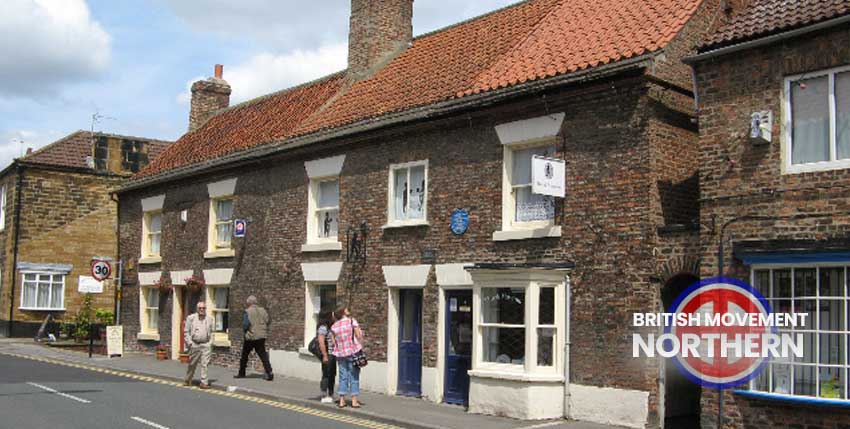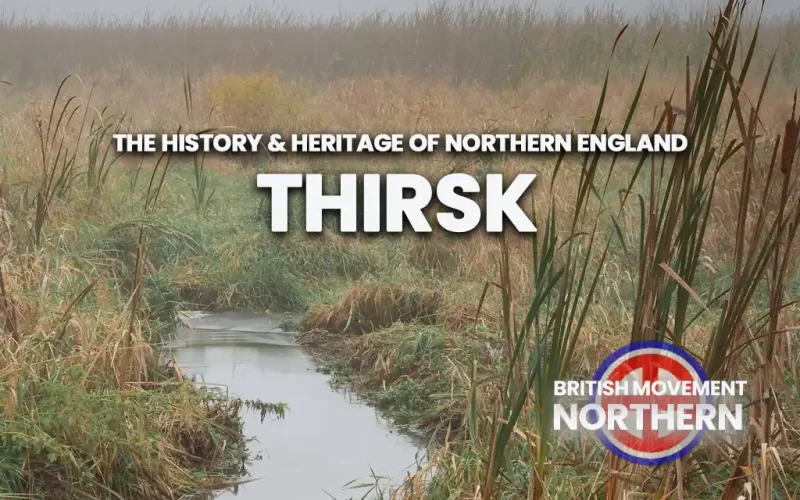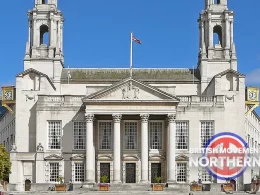Thraesk. Tresche. Treske. Thresk. Thurske. Throsh. Thruston.
As with many northern towns, Thirsk grew out of a tiny settlement and has undergone many spelling variations of the towns name. Academics are sometimes divided as to whether the modern town name Thirsk has its roots in Anglo-Saxon, taken from two local landowners Orm and Thor; or derives directly from the Old Norse word “presk” meaning either a house by a fen or lake or a house next to a river.
Although there were settlements in this area between 600 and 500 BC, the first records of a settlement of any significance were in the later Anglo-Saxon period. However an ancient, pre-historic burial mound was uncovered close to the centre of the present-day Thirsk, but was destroyed over a century ago. The amateur excavation of the burial mound uncovered the skeleton of the so-called ‘Saxon Giant’, although
the human remains were much older.
During the Iron Age there appears to have been no significant settlement in the area, the region was as with much of the territory north of the Humber under the control of the Brigantes tribe and its subordinates.
The Roman Occupation of northern Britain had no impact on the Thirsk area and it was only in the Anglo-Saxon period that an established settlement appeared. The first homesteads being built in the mid-6th Century, their Anglian owners being sworn to the kingdom of Deira, later being absorbed into the larger kingdom of Northumbria.
In the period of the Danelaw, the settlement of ‘Thraesk” was ruled by the Scandinavian kings of Jorvik, (York). Later described as ‘Tresche’ for administrative and taxation the settlement was part of the Wapentake of Yarlstre. The first identifiable written records occur after the Norman Conquest in the Domesday Book, two holdings at “Tresche” made up of ten households are noted in the entry made in 1086.
In keeping with the established pattern set by the Norman overlords, the settlement of ‘Tresche’ was taken from its Anglo-Saxon lords and ownership passed half to Hugh, son of Baldric and half to the Crown. As a reward for loyalty to the Crown, the estates passed to William of Mowbray, a Norman nobleman who was a descendant of Baron d’Aubigny, a Norman knight who had fought alongside William the Conqueror in the invasion of 1066.
The Mowbray family established their manorial home at Thirsk and in 1145 the Crown granted what is now Old Thirsk its market charter allowing the town to develop as a centre for local commerce. In 1176 the Mowbrays built a motte and bailey castle at Thirsk, unfortunately this castle was destroyed after the Mowbrays backed the losing side in an uprising against King Henry II.
In the early 13th Century the Mowbray family were again at odds with the Crown and William de Mowbray, the Sixth Baron of Thirsk travelled south with his retinue and was one of the signatures on Magna Carta in 1215.
Across the Middle Ages, in keeping with many parts of Northern England, the Thirsk area was troubled by raiding war bands from Scotland. In 1322 a Scottish army burned and destroyed the de Mowbray’s manor house at Thirsk.
After the Wars of the Roses, King Henry VI imposed heavy taxes on his nobles which led to another uprising in the North by angry landowners and nobility including the de Mowbrays. It is recorded that Henry Percy, the Earl of Northumberland was murdered at Thirsk while trying to collect taxes for the King.
In the 18th Century a Thirsk gentleman, Thomas Lord went to live in London to seek his fortune and after years of success in business was able in 1755 to establish Lord’s Cricket ground, a link to Thirsk in the world of English cricket resulted.
In modern times, Thirsk has established itself as a thriving market town with strong links to tourism and horse-racing. The author ‘James Herriot’ set his veterinary books in the fictional town of ‘Darrowby’, which was actually Thirsk, and the town has since cashed in on the tourism linked to the subsequent TV series and films.
Thirsk has never truly industrialised and remains a focus for the surrounding rural areas with a regular livestock market and livestock auctions.
Thirsk is a White Town; the most recent census data gives the population break down as 94.3% White British, 3% other White nationalities, 0.9% Asian, 0.2% black or mixed race.
Resources:
Below Image: Thirsk Museum, Kirkgate by Stephen Armstrong, CC BY-SA 2.0 https://creativecommons.org/licenses/by-sa/2.0, via Wikimedia Commons.

The British Movement welcomes articles for possible inclusion on this site from members and supporters across the North of England. Please remember that we have to operate within the laws of this country – we will not include any content that is against the current laws of the United Kingdom. News reports should be topical and be relevant to the regions covered by this website.












